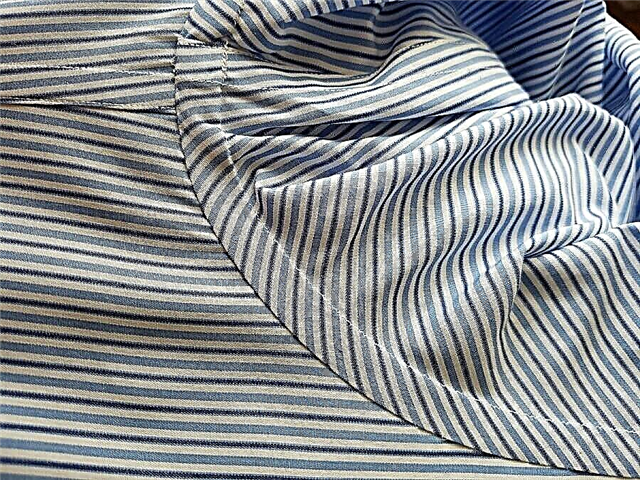In the second part of the master class, we will consider opening the armholes as a decorative technique, emphasizing the status of the product. Perform the construction and processing of a Neapolitan or "cocktail" cuff.
In the first part of the workshop “Processing sleeves in a men's shirt using Italian technology”, we examined the processing of the section of the sleeve cut and prepared the sleeves for embedding in closed armholes.
Processing sleeves in a man’s shirt using Italian technology: sleeve slit
Now we directly proceed to the stitching of sleeves. At this stage, yoke should be stitched to the details of the shelves and back, the side seams of the shirt should be stitched with a seam.
Step 1
Combine the marks of the shoulder seam on the yoke and the top of the sleeve ridge. If a combination of the fabric pattern on the yoke and sleeve in this section is required, combine! Sweep sleeve into armhole from sleeve side. In this case, the side seam of the shirt and the lower seam of the sleeve may not match. This processing method makes it possible to adjust the sleeve fit, especially in shirts of an adjacent silhouette with a normal or shortened shoulder length.

Then stitch the landing from the side of the sleeve to a depth of 2-3 cm from the edge.
Step 2

Stitch the sleeves in the armholes with a seam width of 1.0 cm. Lay the seam from the side of the sleeve. Iron in the seam allowance for sewing on the shelves and back.
Step 3

Remove the basting stitch, iron the oversized seam allowance around the armhole allowance, stab or sweep.

Sew a stitch seam manually with hidden stitches. Stitches should be very frequent and capture only 1−2 threads of fabric shelves and backs.

Only small, barely noticeable punctures should remain on the front side.
Contrary to popular belief, manual opening of armholes does not add either comfort to the sleeves or strength of the seams; this is an exclusively decorative technique that emphasizes the status of the product.
Next, proceed to the processing of the cuff of the shirt
In this workshop, the construction and processing of a Neapolitan cuff will be considered.

Neapolitan cuffs (also known as "cocktail cuffs") look like French double cuffs, but they are not fastened with cufflinks, but with buttons. Button cuffs are the most common, as they are more suitable for everyday wear, unlike French cuffs, which belong to a more formal classic wardrobe. For example, with a tuxedo, it is customary to wear exclusively shirts with French cuffs.
Step 4

Prepare a cuff pattern. The length of the cuff in the finished form is equal to the girth of the wrist plus 1.0−2.0 cm for freedom of fitting and plus 5.0 cm for the clasp. The width of the cuff in the finished form is equal to 7.0-8.0 cm. The Neapolitan cuff differs from the usual button cuff in that it has a flap portion that is turned upwards. The take-off part of the cuff does not have a fastener, therefore its lateral parts are rounded. The width of the take-off part lies 0.5–1.0 cm wider than the main one to overlap the seam of the cuff.
Note
The left cuff is sometimes made to order more than the right one (such a cuff is called a “clock cuff”). It will be more convenient for owners of large watches like Rolex or Breitling. In this case, the measurement of the wrist girth in hours is additionally taken, and the length of the cuff is calculated from it.
Step 5
Cut 4 cuff details along the lobar. At the same time, pay attention to the symmetry of the fabric pattern relative to the cuff bend line. Leave processing allowances for the cut of the cuff stitching - 1.5 cm, and for departure and side parts - 0.7-1.0 cm.

Cut out the adhesive strip without allowances in 2 or 4 copies, depending on how dense doublerin you have and what rigidity of the cuffs you want to achieve.

Duplicate only internal or all 4 cuff details. Iron the seam allowance for sewing the cuff on the inner cuffs. Sew on 1.0-1.3 cm from the fold.
10 unusual ways to sew a button
Step 6

Fold the outer and inner cuffs in pairs with the front side inwards, sweep, grind along the outer cut.

Cut the seam allowances to a width of 0.3-0.5 cm, cut on the curves. Iron the seam of the grind. To turn out a cuff, to sweep out and to iron.

Fold the cuff along the inflection line, draw a line along the bent section of the inner cuff. Equip the seam seam allowance.
Step 7

Place the outside of the cuff with the front on the front of the sleeve. The excess width of the sleeves to lay in the folds. On the front of the sleeve, make 2−3 pinches aimed at the strap of the sleeve. If the difference between the volumes of the sleeve and the cuff is large, you can add another small pin to the bottom of the sleeve.

Stitch the cuff to the sleeve, lay the seam 0.1-0.2 cm from the intended line. Iron the seam allowance onto the cuff.
Step 8

Baste the inside of the cuff. The edge of the cuff should overlap the seam of the seam by 0.1 cm. Lay the reinforcing stitch 0.1 cm from the fold.
Step 9

Perform manual fastening on the sleeve strip: make a jumper with several stitches only on the front side of the fabric.

Then entwine it, grabbing the fabric with overcast stitches.

The strip and the cage, located diagonally on the details of the inlay, are more of a decorative character. And vice versa, on the details cut out according to the share, the exact coincidence of the picture with the detail of the sleeve is an indispensable element, talking about the skill of the tailor.
Sewing school: finishing stitch
Step 10
Lay the finishing stitch on the cuffs.

To sew out loops on a level and a cuff on the machine or manually. The length of the buttonhole is 2–3 mm longer than the circumference of the button. The size of the buttons for the sleeve strap should be slightly smaller than for the cuff.
Note
The hinges on the bar are located in the middle and can be directed along or across the part. As a rule, Italian tailors arrange loops across, this prevents their spontaneous unfastening.
The loops on the cuff can be swept out in the center, and can be slightly shifted to the seam of the cuff when the customer does not want the button to be visible from the sleeve of the worn jacket.
The cuff can be fastened with 1-2-3 buttons located vertically one above the other. But the classic cuff has 1 button, other options relate to a more informal style.

Sew buttons on a twisted leg on the cuff and strap of the sleeve.
Sew a button and make a leg of thread, like a real pro
The author of the master class and photo: Elena Lenkova

Lena has a higher and special education - a tailor of outerwear for men, women and children.
In clothes, he appreciates the individuality and thoughtfulness of the image, the originality of the cut. He likes to analyze modeling techniques and product processing technology. Leads his page on Instagram. Many people know Lena as a longtime user of the BurdaStyle.ru website.
"The quality of processing and the interior decoration of the product are integral aspects of sewing."
Material prepared by Julia Dekanova



